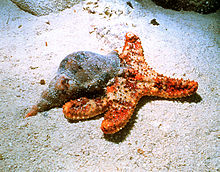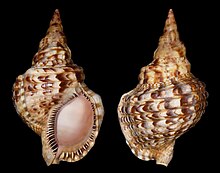Charonia variegata
| Charonia variegata | |
|---|---|

| |
| A live C. variegata feeding on a starfish | |

| |
| Two views of a shell of C. variegata | |
| Scientific classification | |
| Kingdom: | Animalia |
| Phylum: | Mollusca |
| Class: | Gastropoda |
| Subclass: | Caenogastropoda |
| Order: | Littorinimorpha |
| Family: | Charoniidae |
| Genus: | Charonia |
| Species: | C. variegata
|
| Binomial name | |
| Charonia variegata (Lamarck, 1816)[1]
| |
| Synonyms[2] | |
|
List
| |
Charonia variegata, the Atlantic triton or Atlantic triton's trumpet, is a species of predatory sea snail, a marine gastropod mollusk in the family Charoniidae, the triton snails, triton shells, or tritons.[2]
Distribution[]
This species has a wide distribution. It has been found in European waters, the Mediterranean Sea, in the Atlantic Ocean along Cape Verde, off the Canary Islands, North West Africa, and Tanzania, in the Caribbean Sea and the Gulf of Mexico, and from North Carolina to eastern Brazil.[2]
Description[]
The shell size varies up to 375 millimetres (14.8 in)[3] The maximum recorded shell length is 374 millimetres (14.7 in)[4] This conical shell has an elongated and sharply pointed spire without any knobs, but somewhat squatter than the spire of the Pacific Charonia tritonis. The lower whorls are unevenly swollen with a varix and bulge over the suture. The suture then descends in an uneven spiral. The parietal callus is lined with a narrow, dark inner lip, covered with regularly spaced, brown, rib-like plicae. The outer lip is scalloped but less projected and toothed with about 10 pairs of rib-like teeth superimposed on square, dark brown blotches. The color of the shell is mottled in shades of creamy white to yellow with brown markings. The inside of the large aperture is orange pink, and the interior is white.[5]
The species is highly variable and does not have any known geographic subspecies.[6]
The veliger larvae have a period of pelagic development of more than three months, drifting in the trans-Atlantic currents. These larvae are the largest known of any Ranellidae in the Atlantic; the larval shell reaches 5 millimetres (0.20 in) when fully developed.[7]
Habitat[]
Minimum recorded depth is 0.3 metres (0.98 ft) 0.3 m.[4] Maximum recorded depth is 110 metres (360 ft).[4] Thin-shelled 'crabbed' examples have been found in traps off the west coast of Barbados at depths around 155–185 metres (509–607 ft).
A live Charonia variegata found in south Crete, Greece
References[]
- ^ Lamarck J. B. de. (1816). Tableau encyclopédique et méthodique des trois règnes de la Nature. Paris.
- ^ a b c Charonia variegata (Lamarck, 1816). Retrieved through: World Register of Marine Species on 4 December 2018.
- ^ Macsotay O. & Campos. R. 2001. Moluscos representativos de la plataforma de Margarita. Editora Rivolta. Valencia. 280p. ISBN 980-328-808-3
- ^ a b c Welch J. J. (2010). "The "Island Rule" and Deep-Sea Gastropods: Re-Examining the Evidence". PLoS ONE 5(1): e8776. doi:10.1371/journal.pone.0008776.
- ^ Charonia variegata. Sealife base.
- ^ Clench & Turner, The family Cymatiidae in the Western Atlantic, Johnsonia 3, pp. 189-244, 1957
- ^ Rudolph S. Scheltema, Larval dispersal as a means of genetic exchange between geographically separated populations of shallow-water benthic marine gastropods, Biol. Bull. 140, pp. 284–322, April 1971
Further reading[]
- Lamarck, J. B. de. 1816. Tableau encyclopédique et méthodique des trois règnes de la Nature. Paris, page(s): pl. 421, Liste, p. 5
- Rolán E., 2005. Malacological Fauna From The Cape Verde Archipelago. Part 1, Polyplacophora and Gastropoda
- Rosenberg, G., F. Moretzsohn, and E. F. García. 2009. Gastropoda (Mollusca) of the Gulf of Mexico, Pp. 579–699 in Felder, D.L. and D.K. Camp (eds.), Gulf of Mexico–Origins, Waters, and Biota. Biodiversity. Texas A&M Press, College Station, Texas
External links[]
- Photos of Charonia variegata on Sealife Collection
| Wikimedia Commons has media related to Charonia variegata. |
- Charoniidae
- Molluscs of the Atlantic Ocean
- Molluscs of the Indian Ocean
- Molluscs of the Mediterranean Sea
- Molluscs of Central America
- Fauna of the Bahamas
- Molluscs of Mexico
- Fauna of Western Sahara
- Molluscs of Brazil
- Molluscs of the Canary Islands
- Gastropods of Cape Verde
- Invertebrates of West Africa
- Invertebrates of North Africa
- Invertebrates of Tanzania
- Taxa named by Jean-Baptiste Lamarck
- Gastropods described in 1816
